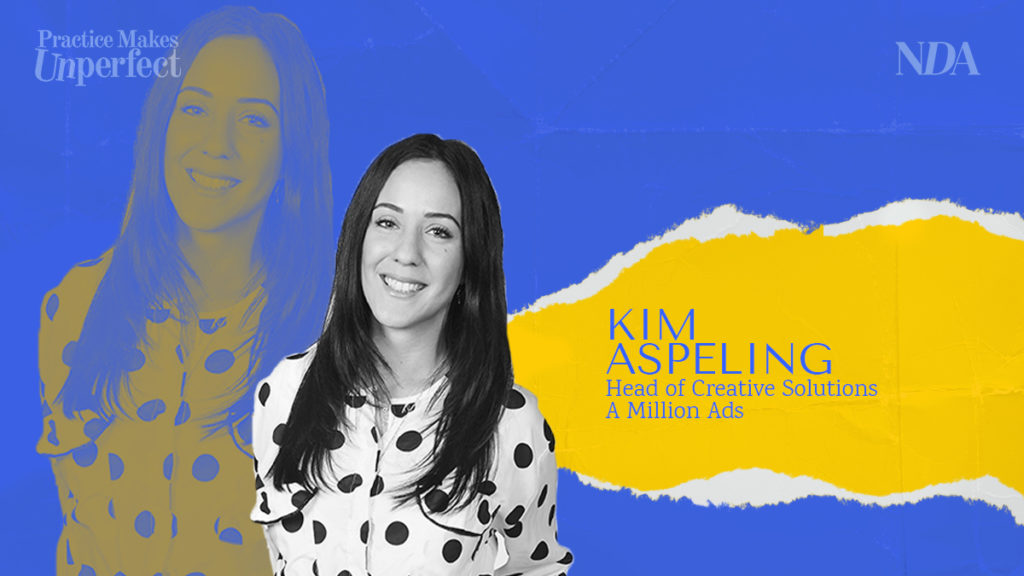These articles have been written by the latest cohort of the Practice Makes UnPerfect programme – a course that helps women find and finesse their public voices.
By Kim Aspeling, Head of Creative Solutions, A Million Ads
Picture this: piping hot, salty, vinegar-drenched chips on a scorching summer’s day… sand on your skin, salt in your hair and the best part? No significant dent to your bank account!
You can understand why you’d want to recreate that same satisfied, money-saving feeling with everything you pay for, including creative production.
As life becomes more digital and the rise of pay 2 play voiceover sites, production and freelancer portals allow you to access almost every profession in the creative field quickly and inexpensively, it’s no wonder clients think that all creative could (and should) be cheap as chips.
Do people actually use these sites?
In 2019 Fiverr was estimated to be worth almost $1 billion dollars, and that’s pre-pandemic. When the world stopped in 2020 and all production went digital, the numbers soared even further, with hundreds more sites popping up and piggy-backing off of an ‘uber’ style workforce, where everything could be sorted from your phone, on a sun lounger or even on the bog.
How do these sites work?
Different sites work in different ways. Some are specific to a profession such as voiceovers.co.uk or Bodalgo which caters specifically to voice over talent. Others such as Upwork or Fiver host numerous professions, from designers to translators. Some pricing models are based on ‘bidding’ where freelancers can auction off their services to the highest bidder but sellers are forced to price low in order to compete in an oversaturated market.
You then get the subscription sites, which are more common in the Voiceover world. Voiceover artists pay to have a profile and share auditions, while potential clients pay a rate determined by the project complexity and usage, with the site taking a cut.
Should I get involved?
With 5.5 million clients and 830,000 freelancers on sites like Fiverr and 1 million voiceovers registered to sites like Voice123, it’s clear to see that there’s a market for these sites, but it’s important to understand what the best use cases are in order to use them effectively.
The Pros:
- It’s perfect for those smaller budgets (WHICH DO EXIST)
Having worked across big advertising agencies through to small start-ups, every now and then you’ll get a client who just doesn’t have a lot of budget. Perhaps it is a test campaign, a small local business, an internal PR piece, or a not for profit. Either way, the creative budget just isn’t there and so although the final output from freelancer sites might not be the all-singing-all dancing creative, the ad will do what it says on the tin.
- Provides production efficiencies across personalised creative
Everyone is talking about data within creative! With personalised creative comes hundreds of production assets that may need to be created. Although ad tech companies like A Million Ads can aid this by taking hundreds of assets to generate millions of variations, those hundreds of versions still need to be produced. With voiceover pay to play sites and synthetic or AI voices, the recording process becomes a more streamlined and cost effective way to achieve this without spending hours in an expensive recording studio. Freelancer portals can also aid in creating assets autonomously, where the creative has been done beforehand and the output from these sites is simply tweaking and generating multiple versions of the same thing. As advertising becomes more hyper- targeted as opposed to just reach, it’s important that the production budget doesn’t outweigh the media spend and that’s where these sites can play an integral role.
- Allows global production from a centralised hub
Post-COVID has brought the entire world even closer than it was before with more and more centralised hubs responsible for creative output across multiple markets. This means that access to translators, producers and voice overs with different accents or who speak different languages, has become pivotal to creative production and these sites fill the gap in successfully producing these global campaigns.
- A chance to break into a new industry
Before the internet boom of 1995, changing careers was not only practically unheard of but anyone who did decide to make the big life change would have found it very difficult to then break into their new industry. These sites allow newbies in the industry to gain experience and exposure in their new profession as well as explore which area of the field they are most interested in.
The Cons:
- Undercuts professional rates
With projects not being charged according to standard industry rates and people trying to outbid each other to win the job, freelancers are unable to fairly compete. It also means that outside of these sites the industry rate card is constantly challenged by clients.
- Bad creative is harmful
Because a lot of the talent on these sites are unvetted and a client can’t always distinguish between good and bad creative, if the final output of the ad isn’t great this could cause an ad to be ineffective. The greater damage however would be that if the ad doesn’t get the desired results, the client won’t want to invest in that channel anymore.
- Innovation becomes stagnant
Many of these sites have very quick turnaround times however with limited time to create, experiment and innovate, it means that we are slowing down innovation across our industry. ‘Settling for’ instead of ‘striving for’ and with more and more brilliant talent losing out on work due to these sites, this stunts innovation growth across the advertising industry as a whole.
- Sets unrealistic expectations
The majority of these sites not only have bidding wars to drive down prices but contain unrealistic expectations like 24 hour turnarounds and unlimited & free amends. This sets an unrealistic precedent for clients going forward. This means for every creative production project going forward they will expect these same parameters, when in reality, timelines are in place to ensure enough time is given to do a good job while limited amends are there to encourage consolidated feedback and pressure on the creative to get it right early on in the process.
So what can we do about it?
These sites aren’t going anywhere and as self-serve, AI, synthetic voices and work-from-anywhere culture becomes the norm, more people will adopt this way of working. Thus we need to co-exist and learn from the reasons why clients go cheap. We cannot rely on these sites to change how they work but we can adopt new ways of working ourselves to help meet this demand.
By challenging how we work, offering a more streamlined production process and defining a different way of working with smaller budgets, we can be more inclusive of clients with different restrictions.
It is our responsibility to understand the reasons for cheap creative in order to save good creative, but it is the clients responsibility to respect the difference.









